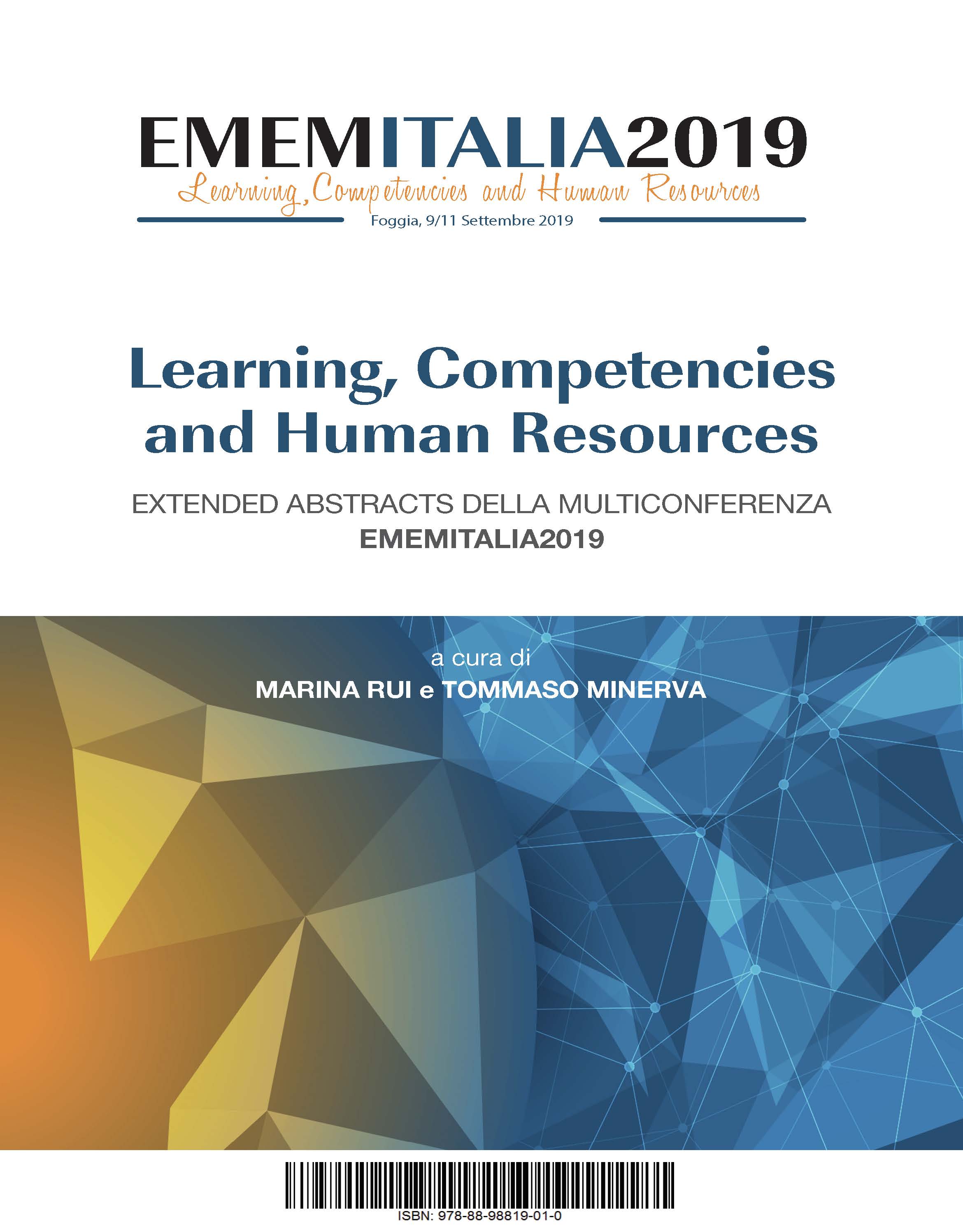- Learning Design,
- Curricolo,
- Graphic Organizer,
- Trasformatività,
- Professionalizzazione
Copyright (c) 2020 Reports on E-learning, Media and Education Meetings

This work is licensed under a Creative Commons Attribution-NonCommercial-ShareAlike 4.0 International License.
Abstract
Il contributo presenta il processo di sviluppo di un'applicazione in grado di produrre artefatti visuali per la progettazione didattica, pensata in base ai principi del Learning Design e del Visual Design.
L'app DEPIT (Designing for Personalisation and Inclusion with Technologies) nasce da un'indagine per far emergere i bisogni dei docenti a livello di progettazione e si sviluppa in forma di generatore di Graphic Organizer condivisi tra docenti e studenti, in grado di reificare e sostenere il processo didattico in termini di organizzazione, orientamento, allineamento, coerenza tra macro e microprogettazione.
La sperimentazione condotta mette in evidenza la trasformatività dell'app prima, durante e dopo l'azione didattica e coinvolge tanto la disposizione all'apprendimento dei discenti, in termini di orientamento e di consapevolezza nei percorsi didattico-disciplinari, quanto la postura del docente, sia a livello di organizzazione e gestione del processo di insegnamento-apprendimento, sia di riflessività in azione e sull'azione.
References
- Bader, J.D. & Lowenthal, P.R. (2018). Using visual design to improve the online learning experience: a synthesis of research on aesthetics. In I. Bouchirka, N. Harrati, & P. Vu (Eds.), Handbook of research on learner experience and usability in online education (pp. 1-35). Hershey, PA: IGI Global.
- Conole, G. & Wills, S. (2013). Representing learning designs – making design explicit and shareable. Educational Media International, 50(1), 24-38.
- Falconer, I. & Littlejohn, A. (2009). Representing models of Practice. In L. Lockyer, S. Bennett, S. Agostinho S., & Harper, B. (Eds.), Handbook of Research on Learning Design and Learning Objects: Issues, Applications, and Technologies (pp. 20-40). Hershey, PA : IGI Global. DOI:10.4018/978-1-59904-861-1.ch002.
- Fedeli, L., Pennazio, V. & Pentucci, M. (2019). A Digital Map as a Representational Tool Implications for the Instructional Design Process. In A. Luigini (Ed.), Proceedings of the 1st International and Interdisciplinary Conference on Digital Environments for Education, Arts and Heritage. EARTH 2018 (pp. 608-617). Heidelberg : Springer. DOI: 10.1007/978-3-030-12240-9_63.
- Gomez Zaccarelli, F., & Fishman, B. J. (2017). Design-Based Implementation Research: Building bridges between practice and research. In P. De Oliveira Lucas & R. Ferrareto Lourenco (Eds.), Temas e Rumos as Pesquisas em Linguística (Aplicada): Questoes Empiricas, Eticas e Praticas. (Vol. 2, pp. 211–228). Campinas, SP: Pontes Editores.
- Hattie, J. (2012). Visible Learning for Teachers. Maximizing impact on learning. London – New York : Routledge.
- Kimbal, M.A. (2013). Visual Design Principles: an empirical study of design lore. Journal of Technical Writing & Communication, 43(1), 3-41. DOI: https://doi.org/10.2190/TW.43.1.b.
- Koper, R. (2005). An introduction to Learning Design. In R. Koper, C. Tattersall (Eds.), A Handbook on Modelling and Delivering Networked Education and Training (pp. 3-20). Verlag – Berlin – Heidelberg : Springer. DOI: 10.1007/b138966.
- Laurillard, D. (2002). Rethinking University Teaching. A Conversational Framework for the Effective Use of Learning Technologies. London : Routledge.
- Laurillard, D. (2004). Rethinking the teaching of science. In R. Holliman & E. Scanlon (Eds.), Mediating science learning through information and communications technology (pp. 27–50). London : Routledge.
- Laurillard, D. (2012). Teaching as a design science. Building Pedagogical Patterns for Learning and Technology. London : Routledge.
- Mor, Y., Ferguson, R., & Wasson, B. (2015). Learning design, teacher inquiry into student learning and learning analytics: A call for action. British Journal of Educational Technology, 46(2), 221-229.
- Rivoltella, P.C. & Rossi (2019). Il corpo e la macchina. Tecnologia, cultura, educazione. Brescia : La Scuola.
- Rossi, P.G. (2016a). Progettazione didattica e professionalità docente. PROPIT: l’artefatto progettuale come mediatore didattico. In P.G. Rossi & C. Giaconi (Eds.), Micro-progettazione: pratiche a confronto. PROPIT, EAS, Flipped Classroom (pp. 13-38). Milano : FrancoAngeli.
- Rossi, P. G. (2016b). Alignment. Education Sciences & Society, 7(2), 33-50.
- Rossi, P.G. (2017a). Visible Design. Rivista Fuentes, 19(2), 23-38. DOI: http://dx.doi.org/10.12795/revistafuentes.2017.19.2.02
- Rossi, P.G. (2017b). The curriculum, the macro design and the micro design, and the curriculum transposition. Education Sciences & Society, 8(2), 26-41.
- Starling, J. M. (2017). The effects of graphic organizers on the comprehension of expository text: examining individual differences for the multimedia principle based on visuospatial abilities. Muncie : Ball State University.
- Wang, F., & Hannafin, M. J. (2005). Design-based research and technology-enhanced learning environments. Educational technology research and development, 53(4), 5-23. DOI: https://doi.org/10.1007/BF02504682
